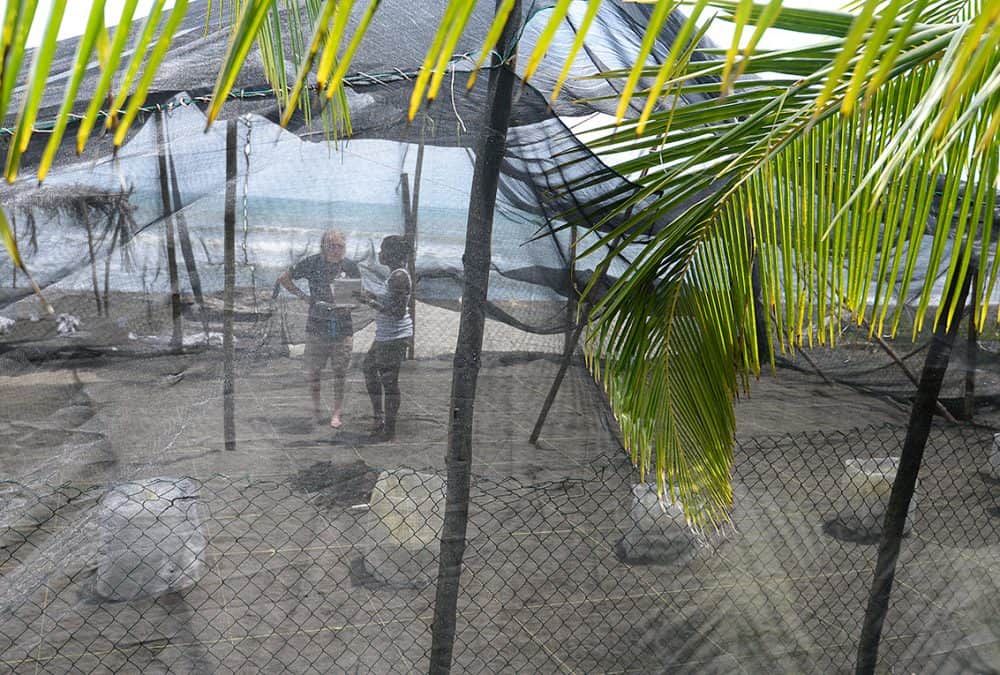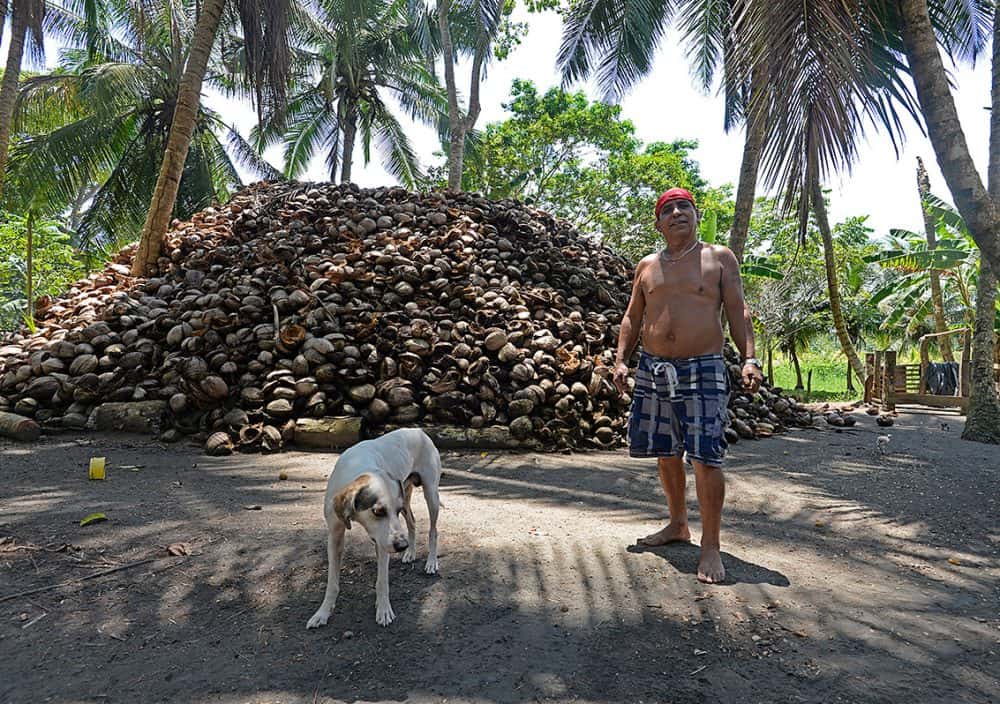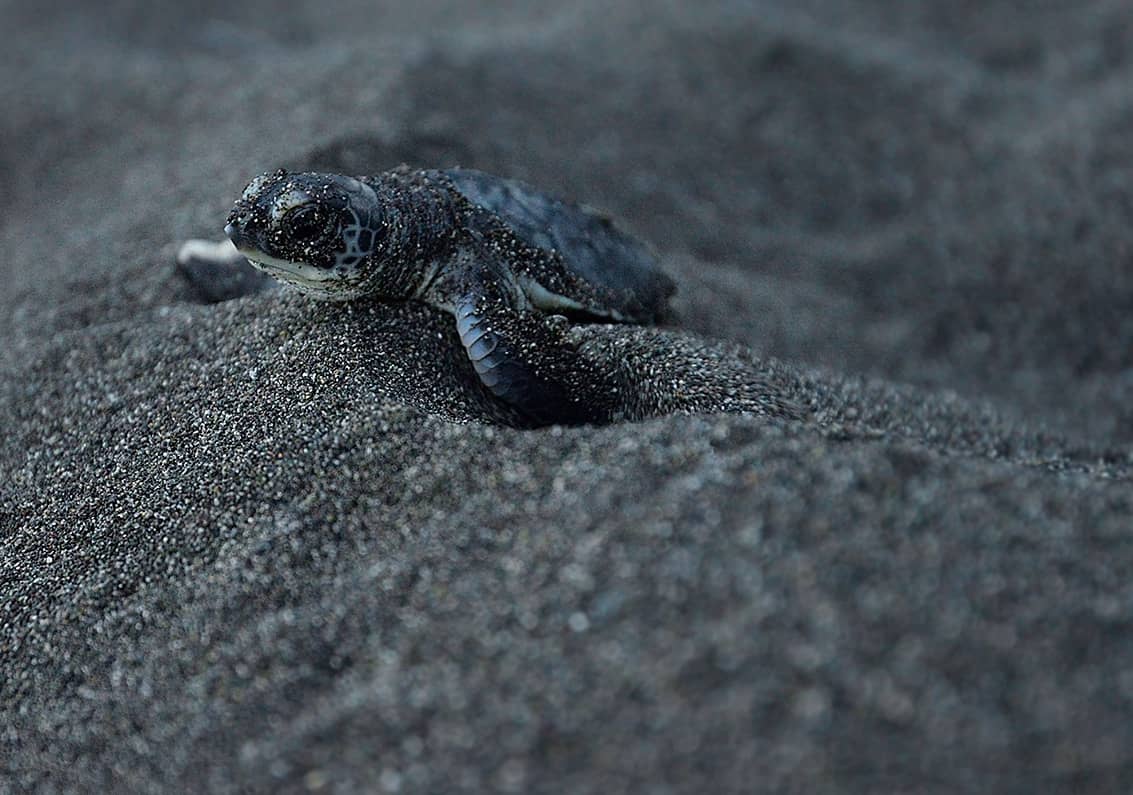Guided by the dim light from a crescent moon, we stumble our way down the uneven sand of Pacuare’s beach. It’s 2 a.m., but crashing waves and the shrill chimes of cicadas fill the night with unsettling noises. The darkness is isolating, but a quick flash from a headlamp up ahead reminds us that we are not alone. For a moment, I’m confused, until I hear the word huevero – poacher – from one of my patrol companions ahead.
For my two fellow beach walkers, employees with a nearby turtle conservation program, these jarring encounters with poachers are a nightly occurrence. Devoid of the traditional jobs in larger cities and towns, the tiny Caribbean community of Pacuare is a haven for turtle poachers. Residents estimate that at least half of the 80-plus community is dedicated to the illegal trade.
The only thing standing between the poachers and the turtles that flock to the beach every year to nest are a fleet of mostly foreign volunteers from turtle protection programs, and a handful of locals who have stepped up to defend the endangered creatures. These turtle guardians will begin to take up their posts in March, merely a month and a half after seven defendants were acquitted of the murder of one of their comrades, 26-year-old sea turtle monitor Jairo Mora, who was killed by alleged poachers in May 2013.
In September, I spent four days in Pacuare with the sea turtle NGO Latin American Sea Turtles (L.A.S.T., formerly WIDECAST). For years L.A.S.T.’s Pacuare Program was able to save hundreds of the beach’s turtles each season, but a growing sense of insecurity spurred by Mora’s murder led to a drastic decline in the number of volunteers in 2014.
Although volunteer numbers have fallen, the number of poachers has not, and the future of Pacuare’s turtles relies on the program’s ability to attract more conservationists to the rescue.
Since sea turtle conservation in Costa Rica began in the 1950s, conservationists and poachers have shared the beaches. Although sea turtle poaching is illegal, it is an unwritten beach law, not Costa Rican law, that governs egg gathering.
The rules are simple: Whoever finds the nest first gets the prize. If the winner is a conservationist, she will gather the eggs and rebury them in a hatchery where they will safely incubate until it is time to hatch. If a poacher gets there first, he will take the eggs and sell them on the black market. If the turtle is still there, he likely will kill it, carve it up and sell its flesh for food.
The beach law was an imperfect system, but it allowed the conservationists and poachers to coexist peacefully for years. Then, one day, it didn’t anymore. Mora’s murder changed everything.
At the time of his death, Mora worked as a sea turtle monitor for WIDECAST. The night of May 30, 2013, he was killed on Moín Beach, on the northern Caribbean coast, while out collecting sea turtle eggs.

Unlike the peaceful coexistence of years past, documents and interview transcripts from the murder investigation paint the picture of a violent war on Moín Beach between conservationists and a group of poachers. Preceding the murder, volunteer turtle workers were held at gunpoint and robbed, and Mora was threatened with an AK-47. A poacher interviewed by police claimed Mora did not respect the law of the beach, while Mora’s allies claimed he did. Either way, it was clear the game had changed; in the Costa Rican Caribbean, poaching is no longer just poaching.
For those already involved in the late night criminal underworld, egg-robbing can make a convenient and lucrative side job. According to police and park rangers with the Environment Ministry, some criminals involved in the drug trade are also known to poach.
Despite being one of the most significant nesting beaches for the endangered leatherback sea turtle, Moín Beach’s criminal reputation has chased off all conservation groups who thought to operate there. Pacuare is now L.A.S.T.’s only remaining Caribbean sea turtle program, and the beach may be the last spot on the Costa Rican Atlantic where turtles can safely lay their eggs.
Getting to Pacuare is an adventure in itself. After taking a two-hour bus ride from San José, a bumpy taxi down dirt roads and a motorboat through a thick jungle canal, we arrive at a small dock emblazoned with the words “Tortugas en peligro cuidémoslas.”
Several rows of nondescript wooden buildings make up L.A.S.T.’s turtle conservation compound. Usually the place is full of volunteers, but I noted that now most of the bunkhouses are empty. The volunteers that were on site milled about the base’s fenced-in backyard, which features a life-sized leatherback turtle statue.
L.A.S.T. has had a program in Pacuare since 2004, with volunteers coming for the leatherback and green turtle seasons from March through October. The volunteers are the only thing that stands in the way of the turtles and hordes of poachers. Although the Costa Rican Coast Guard will occasionally patrol Pacuare, the remote beach village is generally a lawless place. Robberies at other nearby volunteer programs are not uncommon and go virtually unpunished, and poaching can rarely be proven unless police catch the poacher red-handed.
To make up for the lack of a police force, volunteers at Pacuare are constantly sleep deprived. Protecting the turtles requires 24 hours of constant vigilance. Aside from the nightly beach walks, volunteers must also guard the turtle egg hatchery. For safety, no one is allowed alone on the beach at night, so at least two volunteers are needed for every shift. The more volunteers at Pacuare, the more shifts the volunteers can do – and more eggs get saved from poachers.
But after Mora’s death, volunteer numbers fell by nearly 90 percent, although the beach where he was killed is hours away. To make up for the losses, marine conservation organization Sea Shepherd began sending volunteers for the 2014 season. The organization’s controversial leader, Canadian activist Paul Watson, has been vocal about the problems with turtle poaching in Costa Rica, and the organization named their newest ship — now on mission in Africa — the S.S. Jairo Mora Sandoval. It was two Costa Ricans – Mabel Mesen and Erick Saldana – who brought Sea Shepherd to the beach.
“Our main focus with bringing Sea Shepherd to Costa Rica was always the turtles,” Saldana said. “We want to start to turn around what people think about the country.”
Even with their low numbers, the volunteers still stand out in Pacuare, which has population numbers that reflect its remoteness. There are only 40-some full time residents of Pacuare, but the population doubles at the start of nesting season when poachers come in and set up their huts along the beach. Nearly everyone in the village has poached turtles before, and a small encampment of regular poachers sits just up the road from the L.A.S.T.’s volunteer base.

The property belongs to Manuel Cordoba, a 51-year-old farmer who has been in Pacuare for the last 21 years. Cordoba says he used to poach, but that it is no longer worth it.
“I’m too old, that’s a young man’s game,” he said. “Besides, I never made that much money anyway.”
Instead Cordoba farms a small plot and collects coconut husks, which he sells to make oil. A four-story mountain of shells sits along the back of his property as proof of his newly found profession. Still, others on the plot of land do poach. Alberto Castro, 43, who occupies one of the huts near the coconut mountain was caught by the Coast Guard last summer with green turtle flippers on his grill. Castro claims that his arrest has reformed him, but he seems to show little remorse.
“I like the taste of the meat,” he says with a shrug. “People eat this all the time, you can feed your family this way.”
This ambivalence is characteristic of Pacuare and the region as a whole. Turtles are just food, plain and simple. Though resident poachers never expressed a problem with the turtle programs specifically, they seem to see the entire idea of turtle conservation as an imposition from outsiders.
“This is what we do to survive and now all of these other people have come to steal the peace that used to be here,” Castro said. “I’m not against the projects, but the majority of people here eat turtles, and it’s going to be really hard to get rid of that because, let me tell you, that meat is delicious with some coconut.”
But not all the poachers eat turtle meat to survive. According to reports from locals and L.A.S.T. employees, most poachers in Pacuare either sell their turtle products for quick cash or trade them for drugs. During high nesting season, a man boats into Pacuare about once a week to buy meat and eggs, bringing with him cash and bags of crack cocaine. Poachers can get up to $1 per egg depending on the species and between ₡1,000-₡5,000 colones ($2-$10) per pound of green turtle meat (in Costa Rica they do not eat leatherback meat), or the equivalent in drugs. To keep turtle meat fresh, poachers won’t kill the turtle right away after they catch it.
“One day out on the beach we found a turtle turned over on its back with each of its flippers tied up to a tree,” said Alejandra Zúñiga, L.A.S.T.’s resident biologist in Pacuare. “They take the turtles up to the mountains and leave them like that, alive until the man comes to buy them. The turtles suffer for up to a week like that.”
In the Pacuare community opinions on turtle poaching are evenly split. While many in Pacuare have poached and eaten turtles their entire lives, others see poaching as destructive to the community. Elsa Zúñiga, known locally as Doña Elsa, heads up the Pacuare Environmental Association. In her six years in the village she has sought to change the minds of locals about egg poaching.
“The environment is something we have a right to consume, but we need to do so sustainably so our kids and our grandkids can still benefit from it,” she said. “Poaching is not sustainable. Working with these volunteer organizations and helping them grow so they create jobs – that is sustainable.”
Doña Elsa and the Environmental Association work to get members of the community, many of them former poachers, certified to legally handle sea turtle eggs. Once certified, they can be employed by L.A.S.T. to patrol for eggs. As a condition of their employment, the certified patrollers cannot poach eggs. The system effectively converts poachers into conservationists and creates jobs in a community with virtually no employment opportunities.
But the system only works when L.A.S.T. has enough money from volunteers to pay the community employees, something that has been a struggle since Mora’s murder.
Back on the beach, the poacher directs his headlamp’s beam in our direction. He clicks the light on and off as if mocking us, and emits a snorting laugh as he passes by. The encounter could hardly be characterized as violent, but there was something intimidating about his actions. I could feel my shoulders tense up and my pulse quicken as we pushed forward across the dry sand.
L.A.S.T.’s Pacuare volunteers have never had the violent encounters with poachers that they did in Moín, but the relationship is far from friendly.
“The relationship has always been very bitter between the turtle programs and the poachers,” Doña Elsa said. “I would say it is getting better, but before it was dangerous. The volunteers have always been afraid of the poachers and in turn the poachers have always seen them as invaders.”
There is no denying that the volunteer programs put a dent in the poachers’ business. According to a press release from Sea Shepherd, L.A.S.T.’s Pacuare program saved 4,737 eggs between April and October, along with countless adult turtles that were able to lay their eggs on the beach without capture. Without the L.A.S.T. volunteers, poachers would likely have robbed every single one of those nests.
“No, the poachers will never be friendly with the volunteers,” said Eduardo Rangel, L.A.S.T.’s Pacuare station chief. “But we don’t play ball with them the way Jairo did. We aren’t friends, but we respect them and that keeps our volunteers safe.”
According to L.A.S.T.’s program coordinators, volunteer numbers are beginning to return to normal. Patrols will begin again on March 1, and the program leaders are confident they will be able to save more nests than last year. But even with the growing volunteer numbers, the leaders at L.A.S.T. believe there is only one real solution for Pacuare.
“We would need a real police presence on the beach to make a change here,” Rangel said. “Without that, there is no saying what could happen in the future.”






